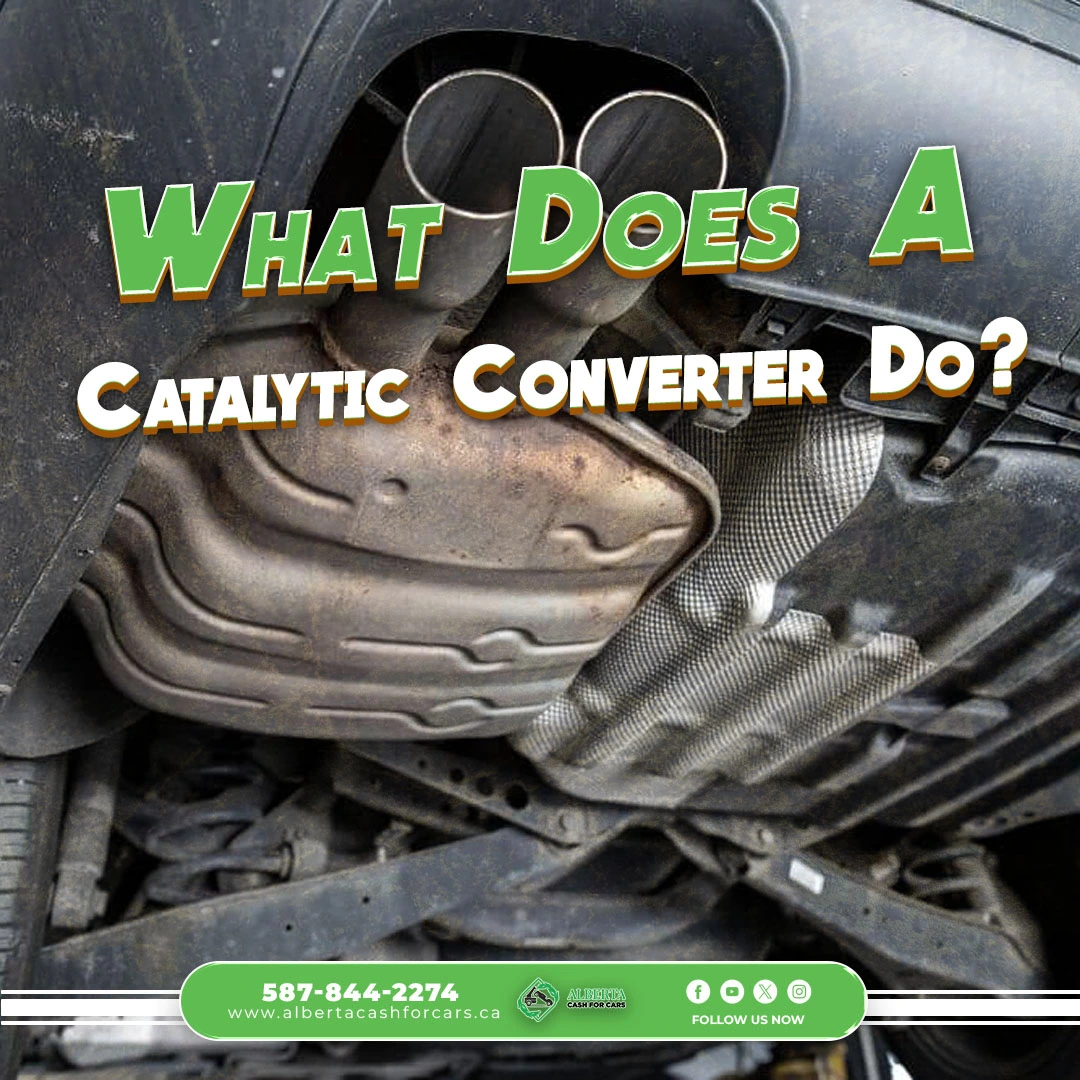Imagine cruising down the highway, windows down, enjoying the fresh air. But wait! A pungent odor creeps in, ruining the moment. That’s the reality without a catalytic converter in your car.
This mysterious device plays a crucial role in keeping our air clean and our rides pleasant. But what does a catalytic converter do exactly? Let’s dive into the world of car parts and unravel the magic behind this emission-fighting device.
No Hassle, Just Cash — Book Your Free Pickup or Quote Today!

Decoding the Converter
Think of a catalytic converter as a tiny device with a big task: to transform harmful pollutants from your car’s exhaust into less toxic gases.
Honeycomb Structure

Imagine a dense, intricate network of channels. This honeycomb-like structure inside the catalytic converter provides a massive surface area for the magic to happen. It’s like a maze for the exhaust gases, ensuring they come into contact with the catalyst beads.
Catalyst Beads
These tiny beads, coated with precious metals like platinum and palladium, are the real stars of the show. They act as reaction accelerators, speeding up chemical processes without getting used up themselves. It’s like adding a little boost to the exhaust gases, helping them transform into less harmful substances.
The Chemistry of Clean Air
So, how do these components work together? Well, picture the hot exhaust gases leaving your engine. They flow through the honeycomb structure, where they come into contact with the catalyst beads. Here’s the science part:
Oxidation
Harmful pollutants like carbon monoxide (CO) and unburned hydrocarbons (HC) react with oxygen (O2) from the exhaust. Thanks to the catalyst beads, these pollutants are transformed into less harmful gases like carbon dioxide (CO2) and water vapor (H2O).
Reduction
Nitrogen oxides (NOx), another group of pollutants, also get tackled. The catalyst helps them combine with nitrogen (N2), the main component of air, rendering them less harmful.
Related Post:
The Impact of a Clean Converter

Catalytic converters play a crucial role in reducing air pollution and improving our environment. Here’s a closer look at the benefits:
Improved Air Quality
Cleaner air means fewer pollutants entering our lungs. This can significantly reduce respiratory problems like asthma, bronchitis, and allergies. Exposure to air pollution has been linked to various health issues, including heart disease, stroke, and cancer.
A cleaner environment can lower the risk of these diseases. Cleaner air can also improve overall well-being and quality of life. Enjoying outdoor activities without worrying about air pollution can make a significant difference.
Fight Against Climate Change
Carbon monoxide and hydrocarbons are greenhouse gases that contribute to global warming. Catalytic converters help reduce the amount of these gases released into the atmosphere, playing a small but important role in combating climate change.
A cleaner environment benefits not only humans but also plants, animals, and ecosystems. By reducing greenhouse gas emissions, we can help protect our planet for future generations.
Pleasant Driving Experience
A malfunctioning catalytic converter can release a strong, unpleasant odor, often described as a rotten egg smell. A clean and functioning converter eliminates this odor, making your drives more enjoyable.
In some cases, a clogged or damaged catalytic converter can affect engine performance. A clean and healthy converter ensures that your car runs smoothly and efficiently.
Warning Signs of a Failing Converter
While catalytic converters are built to last, they can wear out over time or get damaged. Here are some signs to watch out for:
- Illuminated Check Engine Light: common check engine light issue is a general warning, but a faulty converter can trigger it.
- Strong Exhaust Odor: A noticeable rotten egg smell can indicate a failing converter.
- Reduced Engine Performance: You might experience decreased fuel efficiency or a lack of power.
- Rattling Sounds: A loose or damaged converter can create rattling noises from under your car.
Taking Care of Your Catalytic Converter

A well-maintained catalytic converter can provide years of reliable service. Here are some tips for keeping your converter in optimal condition:
Regular Maintenance
Adhere to your car’s manufacturer’s recommended maintenance schedule, including oil changes, spark plug replacements, and tune-ups. These regular checks help ensure your engine is running smoothly, which can indirectly benefit the catalytic converter.
If you notice any signs of engine trouble, such as a check engine light or reduced performance, have your car inspected by a mechanic. Addressing underlying issues can prevent further damage to the catalytic converter.
Use High-Quality Fuel
Low-grade fuel can contain contaminants that can damage the catalyst beads. Opt for reputable gas stations and use the recommended fuel grade for your car. High-quality fuel helps maintain the integrity of the catalytic converter and ensures it operates efficiently.
Avoid Leaded Gasoline
Leaded gasoline, while rare in many countries, can be extremely harmful to your catalytic converter. The lead can clog the converter’s pores and render it ineffective. While leaded gasoline is largely phased out, it’s still available in some regions. Check your local regulations to ensure you’re using unleaded fuel.
Conclusion
In conclusion, the catalytic converter is a vital component of modern vehicles that plays a crucial role in reducing air pollution and protecting our environment. Transforming harmful pollutants into less toxic gases, it helps improve air quality, combat climate change, and ensure a more pleasant driving experience.
Regular maintenance, using high-quality fuel, and avoiding leaded gasoline are essential steps to prolong the life of your catalytic converter. If you notice any signs of a malfunction, it’s important to have your car inspected by a mechanic to prevent further damage. By taking care of your catalytic converter, you contribute to a cleaner and healthier world for everyone.




